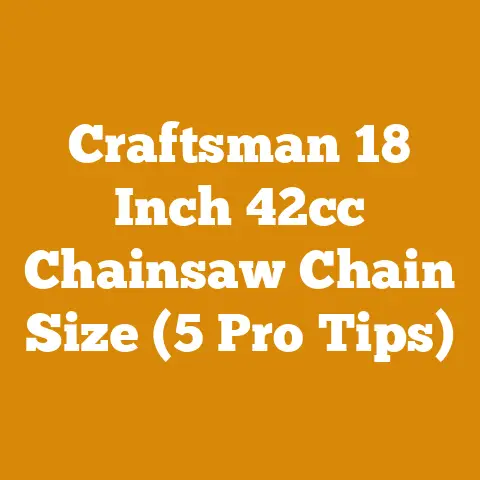Stihl 30 Inch Bar Chainsaw Guide (5 Pro Logging Hacks)
Stihl 30 Inch Bar Chainsaw Guide (5 Pro Logging Hacks)
I know your time is valuable, so let’s get straight to the point. You’re here because you need to make the most of your Stihl chainsaw with a 30-inch bar, and you need it done efficiently. This guide is about maximizing your productivity and safety in the woods. I’ll share five pro logging hacks that I’ve learned over years of experience, along with detailed information on how to properly use and maintain your saw. Let’s dive in and unlock the full potential of your Stihl!
Understanding the Stihl 30-Inch Bar Chainsaw
Before we get to the hacks, let’s make sure we’re on the same page regarding the capabilities and limitations of a Stihl chainsaw equipped with a 30-inch bar. This is a serious piece of equipment, designed for felling large trees and processing substantial timber. I’ve used mine on everything from mature oaks to towering pines, and with the right technique, it’s a beast.
The powerhead you pair with this bar is crucial. A smaller engine will struggle, leading to slow cuts and unnecessary wear and tear. I personally recommend a Stihl MS 462 R C-M or larger for optimal performance. These saws offer the power and torque needed to pull the chain through dense wood.
The 30-inch bar allows you to fell trees up to approximately 5 feet in diameter, depending on the species and your cutting technique. However, remember that longer bars also increase the risk of kickback, so proper safety precautions are paramount.
Takeaway: A 30-inch bar chainsaw is a powerful tool, but requires a powerful engine and careful operation.
Instead of simply cutting straight through the trunk, the bore cut allows you to control the direction of the fall with precision. It also minimizes the risk of pinching the bar, which can be a major headache.
Here’s how I do it:
- Establish the Hinge: First, make a standard face cut (the notch) on the side of the tree facing the direction you want it to fall. This should be about 80% of the tree’s diameter.
- Bore In: Next, carefully plunge the tip of your bar into the tree, just behind the face cut. Maintain a slow and steady speed, and be extra cautious of kickback. I always use a low RPM when starting the bore cut.
- Create the Hinge Wood: Once the bar is fully inserted, pivot the saw to create a uniform hinge of wood. This hinge is what controls the fall, so make sure it’s even and about 10% of the tree’s diameter.
- Felling Cut: Finally, make your felling cut from the back of the tree, leaving the hinge intact. As you cut, the tree will begin to lean in the direction of the face cut.
- Wedges: I always use wedges to help guide the fall and prevent the tree from sitting back on the bar. I use plastic or aluminum wedges depending on the tree size and species.
Why it works: The bore cut allows you to control the fall by creating a hinge that guides the tree. It also reduces the risk of bar pinching, which can be a serious safety hazard.
Real-world example: I once had to fell a massive oak tree near a power line. The bore cut allowed me to drop the tree within inches of my target, avoiding a potentially disastrous situation.
Actionable Metric: Aim for a hinge thickness of 10% of the tree’s diameter for optimal control.
Takeaway: Mastering the bore cut significantly improves safety and precision when felling large trees.
Pro Logging Hack #2: Mastering the Milling Cut
Beyond just felling trees, a 30-inch bar opens up the world of milling lumber on-site. This is incredibly useful for creating custom boards and beams, especially when dealing with unique wood species or sizes that are hard to find commercially. I’ve milled everything from walnut slabs for tabletops to cedar beams for a cabin using this method.
Here’s my approach:
- Invest in a Chainsaw Mill Attachment: There are several excellent chainsaw mill attachments available that clamp onto your bar and provide a guide for making straight, consistent cuts. I personally use a Granberg Alaskan Mill.
- Prepare the Log: Before milling, make sure the log is stable and properly supported. Use wedges or cribbing to prevent it from rolling.
- First Cut: The first cut is the most challenging, as it establishes the initial flat surface. Take your time and use a level to ensure it’s straight.
- Subsequent Cuts: After the first cut, the mill will ride on the flat surface, making subsequent cuts much easier and more precise.
- Sharp Chain: A sharp chain is absolutely essential for milling. I recommend using a ripping chain, which is designed for making cuts along the grain.
Why it works: Chainsaw milling allows you to create custom lumber on-site, saving you time and money. It’s also a great way to utilize trees that would otherwise be left to rot.
Real-world example: I once milled a fallen black walnut tree into beautiful slabs that I used to build a custom dining table. The value of the lumber far exceeded the cost of the milling equipment.
Actionable Metric: Track the board feet of lumber you produce per hour to gauge your milling efficiency. Aim for at least 50 board feet per hour with a well-tuned setup.
Takeaway: Chainsaw milling is a cost-effective way to produce custom lumber, but requires patience, precision, and the right equipment.
Pro Logging Hack #3: The Importance of Chain Maintenance
A dull chain is not only inefficient, it’s also dangerous. It forces you to apply more pressure, increasing the risk of kickback and fatigue. I’ve seen too many accidents caused by dull chains. Regular chain maintenance is crucial for both safety and performance.
Here’s my chain maintenance routine:
- Sharpening: I sharpen my chain after every few tanks of gas, or more often if I’m cutting dirty or knotty wood. I use a Stihl 2-in-1 Easy File for quick and accurate sharpening in the field.
- Depth Gauge Adjustment: The depth gauges (or rakers) control how much wood the chain removes with each pass. If they are too high, the chain will skip and grab. If they are too low, the chain will cut slowly. I use a depth gauge tool to maintain the correct height.
- Chain Tension: Proper chain tension is essential for preventing the chain from derailing and for ensuring smooth cutting. The chain should be snug against the bar, but still able to be pulled around by hand.
- Chain Lubrication: Always use a high-quality bar and chain oil to keep the chain lubricated. This reduces friction and wear, and helps to prevent the chain from overheating. I check the oil level frequently and refill as needed.
- Cleaning: After each use, I clean the chain and bar with a brush to remove sawdust and debris. This helps to prevent corrosion and extends the life of the chain.
Why it works: A sharp, well-maintained chain cuts faster, smoother, and safer. It also reduces wear and tear on your saw, saving you money in the long run.
Real-world example: I once neglected to sharpen my chain before felling a large tree. The dull chain caused the saw to buck and kick back, nearly resulting in a serious injury. I learned my lesson the hard way.
Actionable Metric: Track the number of tanks of gas you use between sharpenings. Aim for at least 3-4 tanks per sharpening for optimal performance.
Takeaway: Regular chain maintenance is a critical aspect of safe and efficient chainsaw operation.
Pro Logging Hack #4: Utilizing Wedges and Felling Levers
Wedges and felling levers are indispensable tools for controlling the direction of a falling tree and preventing the bar from getting pinched. I never go into the woods without them.
Here’s how I use them:
- Wedges: I use wedges to lift the tree as I make my felling cut. This helps to prevent the tree from sitting back on the bar and also helps to guide the direction of the fall. I typically use two or three wedges, depending on the size of the tree. I prefer plastic or aluminum wedges to avoid damaging my chain if I accidentally hit them.
- Felling Lever: A felling lever is a long, sturdy bar that you insert into the felling cut to help push the tree over. It provides extra leverage and control, especially when dealing with leaning trees. I always make sure the felling lever is securely seated before applying pressure.
Why it works: Wedges and felling levers provide extra control and safety when felling trees, especially in challenging situations. They can prevent accidents and make the job much easier.
Real-world example: I once had to fell a tree that was leaning heavily in the wrong direction. Without wedges and a felling lever, it would have been impossible to control the fall.
Actionable Metric: Measure the angle of lean of the tree. For trees with a significant lean (more than 10 degrees), always use wedges and a felling lever.
Takeaway: Wedges and felling levers are essential tools for safe and controlled tree felling.
Pro Logging Hack #5: The Art of Bucking and Splitting for Firewood
Once you’ve felled a tree, the next step is to buck it into manageable lengths for firewood. This is where a 30-inch bar really shines, allowing you to process large logs quickly and efficiently. However, it’s important to use proper techniques to avoid strain and injury.
Here’s my approach to bucking and splitting firewood:
- Bucking: I always buck logs on a stable surface, such as a log pile or a set of skids. This prevents the saw from hitting the ground and reduces the risk of kickback. I use a sawhorse for smaller logs. I also use a measuring stick to ensure that all the pieces are the same length.
- Splitting: For splitting, I use a hydraulic log splitter. This is much safer and more efficient than splitting by hand, especially when dealing with large, knotty logs. I always wear safety glasses and gloves when operating the log splitter.
- Wood Species: The type of wood you’re splitting makes a big difference. Hardwoods like oak and maple are more difficult to split than softwoods like pine and fir. I adjust my splitting technique accordingly.
- Drying: After splitting, I stack the firewood in a well-ventilated area to dry. Proper drying is essential for efficient burning and reduces the risk of creosote buildup in your chimney. I aim for a moisture content of less than 20% before burning.
Why it works: Proper bucking and splitting techniques make the process safer and more efficient. Using a hydraulic log splitter significantly reduces the risk of injury.
Real-world example: I used to split firewood by hand, and I suffered from back pain and fatigue. Since switching to a hydraulic log splitter, I can process much more wood with less effort and less risk of injury.
Actionable Metric: Measure the moisture content of your firewood using a moisture meter. Aim for a moisture content of less than 20% before burning.
Takeaway: Efficient bucking and splitting techniques, combined with the right equipment, can make firewood preparation a much easier and safer task.
Safety First: Essential PPE and Practices
Before you even think about starting your chainsaw, let’s talk about safety. I’ve seen firsthand the devastating consequences of neglecting safety precautions. No job is worth risking your health or life.
Here’s my essential PPE checklist:
- Helmet: A properly fitted helmet is crucial for protecting your head from falling branches and debris.
- Eye Protection: Safety glasses or a face shield are essential for protecting your eyes from flying wood chips and sawdust.
- Hearing Protection: Chainsaws are loud, and prolonged exposure to high noise levels can cause permanent hearing damage. I always wear earplugs or earmuffs.
- Gloves: Heavy-duty gloves protect your hands from cuts, splinters, and vibrations.
- Chainsaw Chaps: Chainsaw chaps are designed to stop the chain in the event of a kickback, preventing serious leg injuries.
- Steel-Toed Boots: Steel-toed boots protect your feet from falling logs and sharp objects.
In addition to PPE, here are some essential safety practices:
- Read the Manual: Before using your chainsaw, read the owner’s manual carefully and understand all the safety instructions.
- Inspect Your Saw: Before each use, inspect your saw for any damage or worn parts.
- Clear the Area: Before felling a tree, clear the area around the tree of any obstacles, such as branches, rocks, or other trees.
- Plan Your Escape Route: Before felling a tree, plan your escape route in case the tree falls in the wrong direction.
- Never Cut Above Your Head: Cutting above your head is extremely dangerous and should be avoided at all costs.
- Be Aware of Your Surroundings: Always be aware of your surroundings and watch out for other people, animals, and hazards.
- Take Breaks: Chainsaw work is physically demanding, so take frequent breaks to avoid fatigue.
- Never Work Alone: It’s always safer to work with a partner, especially when felling trees.
Why it works: Proper PPE and safety practices significantly reduce the risk of accidents and injuries.
Real-world example: I once witnessed a logger who wasn’t wearing chainsaw chaps suffer a severe leg injury when his saw kicked back. The injury could have been prevented with proper PPE.
Actionable Metric: Conduct a pre-work safety checklist before each job to ensure that you have all the necessary PPE and that your saw is in good working order.
Takeaway: Safety is paramount when operating a chainsaw. Always wear proper PPE and follow safe work practices.
Troubleshooting Common Problems
Even with proper maintenance and technique, you may encounter problems with your Stihl 30-inch bar chainsaw. Here are some common issues and how to troubleshoot them:
- Saw Won’t Start: Check the fuel level, spark plug, and air filter. Make sure the choke is in the correct position. If the saw still won’t start, it may need to be serviced by a qualified mechanic.
- Saw Runs Poorly: A dirty air filter or spark plug can cause the saw to run poorly. Clean or replace these components as needed. Also, check the fuel mixture to ensure it’s correct.
- Chain Binds or Jams: This is often caused by a dull chain or improper chain tension. Sharpen the chain and adjust the tension as needed. Also, make sure the bar is properly lubricated.
- Excessive Vibration: Excessive vibration can be caused by a loose chain, a damaged bar, or worn engine mounts. Inspect these components and repair or replace them as needed.
- Chain Comes Off the Bar: This is usually caused by improper chain tension or a worn sprocket. Adjust the chain tension and replace the sprocket if it’s worn.
- Bar Overheats: This is often caused by insufficient lubrication. Make sure the bar oil reservoir is full and that the oiler is working properly. Also, avoid applying excessive pressure to the saw.
Why it works: Troubleshooting common problems promptly can prevent further damage to your saw and keep you working efficiently.
Real-world example: I once had a saw that kept stalling in the middle of cuts. After checking the usual suspects (fuel, spark plug, air filter), I discovered that the fuel line was cracked. Replacing the fuel line solved the problem.
Actionable Metric: Keep a log of any problems you encounter with your saw, along with the solutions you tried. This will help you to identify patterns and troubleshoot problems more quickly in the future.
Takeaway: Knowing how to troubleshoot common problems can save you time and money and keep your saw running smoothly.
Advanced Techniques: Timber Grading and Optimization
For those looking to take their logging skills to the next level, understanding timber grading and optimization is essential. This involves evaluating the quality of the wood and deciding how to best utilize it to maximize its value.
Here’s a basic overview of timber grading:
- Grade Determination: Timber grading involves assessing the wood for defects, such as knots, cracks, and rot. Different grading systems exist, depending on the species of wood and the intended use. For example, hardwood lumber is typically graded according to the National Hardwood Lumber Association (NHLA) rules.
- Log Scaling: Log scaling is the process of estimating the volume of lumber that can be sawn from a log. This is typically done using a log scale, such as the Doyle scale or the Scribner scale.
- Optimization: Once you’ve graded the timber and scaled the logs, you can begin to optimize your cutting strategy. This involves deciding how to buck the logs into lengths that will maximize the value of the lumber. For example, you may want to cut longer lengths of clear lumber for high-end furniture or shorter lengths of lower-grade lumber for firewood.
Why it works: Understanding timber grading and optimization can significantly increase the value of your timber harvest.
Real-world example: I once harvested a stand of timber that contained a mix of high-grade and low-grade trees. By carefully grading the timber and optimizing my cutting strategy, I was able to generate significantly more revenue than I would have if I had simply cut everything into firewood.
Actionable Metric: Track the grade and volume of lumber you produce from each log. This will help you to refine your grading and optimization skills over time.
Takeaway: Timber grading and optimization are advanced techniques that can significantly increase the value of your timber harvest.
Sustainable Logging Practices
As loggers, we have a responsibility to manage our forests sustainably. This means harvesting timber in a way that protects the environment and ensures that future generations will have access to the same resources.
Here are some sustainable logging practices to consider:
- Selective Harvesting: Selective harvesting involves removing only certain trees from a stand, leaving the rest to continue growing. This helps to maintain the health and diversity of the forest.
- Reforestation: After harvesting timber, it’s important to replant trees to ensure that the forest regenerates. This can be done through natural regeneration or by planting seedlings.
- Erosion Control: Logging can cause soil erosion, which can pollute waterways and damage habitat. It’s important to implement erosion control measures, such as installing silt fences and seeding disturbed areas.
- Wildlife Protection: Logging can disrupt wildlife habitat. It’s important to protect wildlife by avoiding sensitive areas and minimizing disturbance.
- Best Management Practices (BMPs): BMPs are a set of guidelines for logging operations that are designed to protect the environment. These guidelines cover a wide range of topics, including erosion control, water quality, and wildlife protection.
Why it works: Sustainable logging practices protect the environment and ensure that future generations will have access to the same resources.
Real-world example: I’ve worked with several landowners who are committed to sustainable forestry. By following sustainable logging practices, we’ve been able to harvest timber while maintaining the health and beauty of their forests.
Actionable Metric: Develop a forest management plan that outlines your sustainable logging practices.
Takeaway: Sustainable logging practices are essential for protecting the environment and ensuring the long-term health of our forests.
Final Thoughts: Mastering Your Stihl 30-Inch Bar Chainsaw
Using a Stihl chainsaw with a 30-inch bar is a serious undertaking, but with the right knowledge, skills, and dedication, you can become a proficient and responsible logger or firewood producer. Remember to prioritize safety, maintain your equipment, and always strive to learn and improve. By embracing these pro logging hacks and sustainable practices, you can unlock the full potential of your saw and make a positive impact on the environment. Now, get out there and make some sawdust!






